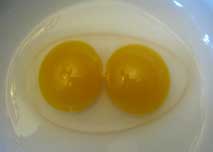Also see information on egg abnormalities
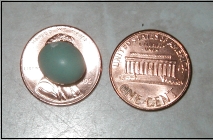
This dwarf Eastern Bluebird egg was laid on July 19, 2006 during a third nesting in Pennsylvania. It was the only egg in the nest, and is being brooded. (This egg is a regular blue color.) Photo by Glenn Williams. More info about bluebirds.
Dwarf eggs are not common. They often lack a yolk. In an egg without a yolk, an embryo would never form, so it would not hatch. They may be more spherical than a normal egg, and have a thick, rough shell. See HOWR dwarf egg. More info.
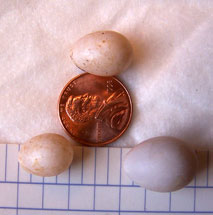
Mini Tree Swallow egg, left behind after fledging. Photo by Bet Zimmerman. The top egg and smaller one on the left are from the same nest, neither hatched (two others did.) The one on the lower right is from a different nest (also didn’t hatch) and is even bigger than the first two.
The two smaller eggs are typically pure white, but had some poopage on them from other hatchlings.
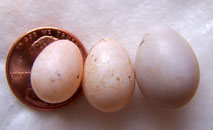
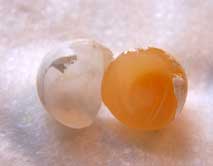 Obviously the smaller Tree Swallow egg pictured above wasn’t a true “dwarf egg” because it had a yolk. I would call it a Runt Egg.
Obviously the smaller Tree Swallow egg pictured above wasn’t a true “dwarf egg” because it had a yolk. I would call it a Runt Egg.
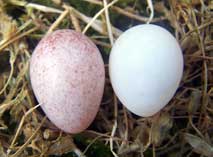
This pure white House Wren egg was laid in mid-July 2006 in CT. This nest attempt was after repeated failures in other boxes. The first egg laid was normal, but maybe a little pale. The second and third eggs were both pure white. All were a bit more pointy than usual. They were brooded, but none of the three eggs hatched. All did have yolks. Photo by EA Zimmerman. More info about House Wrens.
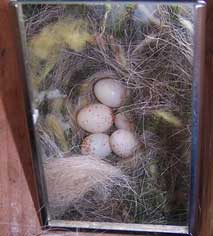 A Black-capped Chickadee egg that only had a wreath on the large end (no other speckles) is at the top of this photo. It was laid the first week of July 2006, in what appears to be a second nesting (rare – not possible to confirm without banding). It did not hatch, nor did the egg on the lower right (also lacking much in the way of speckles.) Photo by EA Zimmerman. More info about Chickadees.
A Black-capped Chickadee egg that only had a wreath on the large end (no other speckles) is at the top of this photo. It was laid the first week of July 2006, in what appears to be a second nesting (rare – not possible to confirm without banding). It did not hatch, nor did the egg on the lower right (also lacking much in the way of speckles.) Photo by EA Zimmerman. More info about Chickadees.
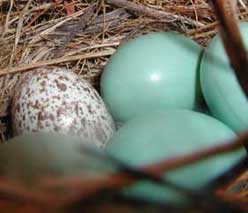
This is actually a cowbird egg in a bluebird nestbox. It is not common to find cowbird eggs in a nestbox that has a regular sized hole (1 1/2″ or 1 9/16″). Photo by Lara Hampton. More info about Cowbirds.
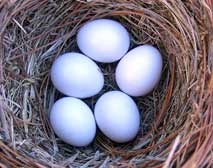
These bluebird eggs are white. Sometimes white bluebird eggs have a pink or blue tinge. They may occur in up to 4-5% of bluebird nests. Photo by EA Zimmerman. See photo of pinkish eggs. See more info on white bluebird eggs.
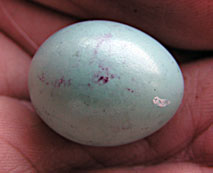
These bluebird eggs were laid in late 2005. When first laid the eggs looked normal. All had weird reddish spots on the outside (berry stains?), and all were infertile. Photo by Cher Layton of The Bluebird Nut.
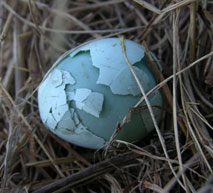
A bluebird egg that had two complete shells. This egg had two complete layers of calcium, with a tiny gap between the layers. The outer shell was thinner and lighter in color than the inner shell. It had a yolk inside it. Keith said a guy at a chicken egg plant said this is not uncommon with older chickens, and had even found some with three layers of shells. Photo and info from Keith Kridler of TX.
Note that sometimes you will see a half shell of a hatched egg flip over and get stuck on top of another egg in the nest.
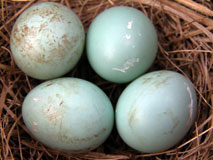
These bluebird eggs have blood on them, and some white streaks of feces. Photo by Keith Kridler, who indicated that he normally sees bloody eggs early in the season – this is a second brood.
See more bloody eggs I saw in Bickleton WA in June 2009.
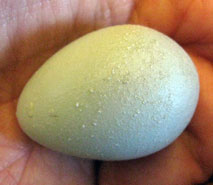 Starling egg with little white sandy looking bumps (excess calcium?) on the shell. Zimmerman photo. This could be a result of excess calcium in the diet, an infectious disease like Newcastle or Infectious bronchitis, or it may be hereditary.
Starling egg with little white sandy looking bumps (excess calcium?) on the shell. Zimmerman photo. This could be a result of excess calcium in the diet, an infectious disease like Newcastle or Infectious bronchitis, or it may be hereditary.
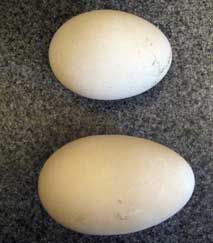
Left: Khaki Campbell duck eggs: the one on top left is typical (from a different female), while the longer, thinner egg below has a double yolk. Above: contents of larger egg. A young hen that just started laying produced double yolks on a regular basis, every other day, for a little less than 2 weeks, and then starting laying single yolked eggs.. More…. 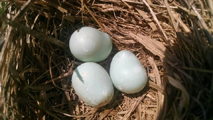 Eggs with shells that are thin, soft, missing or deformed might result from environmental factors (e.g., abnormal heat or humidity, parasites, toxins, stress and molting while egg laying); or nutritional issues (Vitamin E, B12, D, calcium, phosphorus or selenium); disease (infectious bronchitis, infectious laryngotracheitis, egg drop syndrome, ochratoxicosis, or avian influenza). See larger photo.
Eggs with shells that are thin, soft, missing or deformed might result from environmental factors (e.g., abnormal heat or humidity, parasites, toxins, stress and molting while egg laying); or nutritional issues (Vitamin E, B12, D, calcium, phosphorus or selenium); disease (infectious bronchitis, infectious laryngotracheitis, egg drop syndrome, ochratoxicosis, or avian influenza). See larger photo.
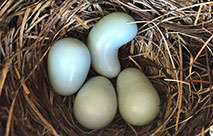 Clutch of four eggs on Woolwine House Bluebird Trail in VA, 2018. 2 eggs hatched, 1 nestling survived.
Clutch of four eggs on Woolwine House Bluebird Trail in VA, 2018. 2 eggs hatched, 1 nestling survived.
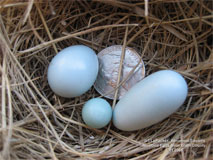 These two abnormal eggs (plus one normal Eastern Bluebird egg added for comparative purposes) were found in one nest in Erath County, TX by Dorothy Reeves. (Photo by L Packer used with permission.) Neither had hatched. The long egg is probably a double-yolker (see above.) The smaller egg was probably laid the following day or the day before, and may be a dwarf egg without a yolk. See larger photo. (A big blue egg could also be a Starling egg if the entrance hole is not properly sized.)
These two abnormal eggs (plus one normal Eastern Bluebird egg added for comparative purposes) were found in one nest in Erath County, TX by Dorothy Reeves. (Photo by L Packer used with permission.) Neither had hatched. The long egg is probably a double-yolker (see above.) The smaller egg was probably laid the following day or the day before, and may be a dwarf egg without a yolk. See larger photo. (A big blue egg could also be a Starling egg if the entrance hole is not properly sized.)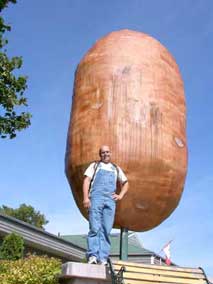
Okay, so this isn’t really an egg. It’s a giant fake potato (with my husband standing next to it for scale) in front of the most excellent Potato Museum on Prince Edward Island. Just wanted to demonstrate that I DO have other interests beyond bluebirds….
EGG ABNORMALITIES (from Mississippi State Extension Service – occurring in chicken eggs from
- Egg within an egg: a result of reversal of direction of the egg by the wall of the oviduct. One day’s egg is added to the next day’s egg, and a shell is formed around both.
- SIZE:
- Dwarf egg: often lack a yolk, in which case they would not hatch. They may be more spherical than a normal egg, and have a thick, rough shell.
- “Runt” egg: Noticeably smaller than the smallest extreme expected by normal variation within a clutch. May be different in shape (e.g., more narrow.) A common egg abnormality in domestic fowl, perhaps more common with young birds, not necessarily the first or last egg, may be due to a temporary disturbance in the reproductive system. (Mulvihill)
- COLOR:
- Bloodspots: caused by a rupture of one or more small blood vessels in the yolk follicle at the time of ovulation.
- Meat spots: really either bloodspots which have changed color due to chemical action, or tissue sloughed off from the reproductive organs of the female.
- SHELL:
- Thin-shelled eggs: may be caused by dietary deficiencies, genetics or disease.
- Soft-shelled eggs: generally occur when an egg is prematurely laid, and insufficient time in the uterus prevents shell deposition. They never harden, and will eventually dessicate. Some reports indicate Avian Flu can cause soft-shelled eggs.
- Glassy or chalk-shelled eggs: are caused by malfunctions of the uterus of the female. Glass eggs are less porous and will not hatch.
- YOLKS:
- Double-yolked: happens when two yolks are released at the same time, or when one yolk is lost in the body cavity for a day and is picked up by the funnel when the next day’s yolk is released. Heredity may be a factor, or it may occur more in young hens just starting to lay. Double-yolked eggs rarely hatch either because the embryos die early on, or because of difficulties pipping. Twin Eastern Bluebirds reportedly hatched from a larger than normal egg (Gerald Clark of State College PA) in 2013. Excellent discussion on double yolks and viability here: http:// lauraerickson.blogspot.com/2012/04/normal.html
- Off-colored yolks: are due to substances in feed.
- Yolkless: formed around a bit of tissue sloughed off the ovary or oviduct. The tissue stimulates the secreting glands of the oviduct and the yolkless egg results.
References and more information:
-
- Candling chicken eggs – The Easy Chicken for beginners
- Runt Eggs: a Discovery, a Synopsis and a Proposal for Future Study, R.S. Mulvihill, North American Bird Bander
- White Bluebird Eggs
- How many eggs will a bird lay
- Egg production
- unhatched eggs– what happened?
- Egg size comparison (different species)
- Nest, egg and young ID
- Photo of pink bluebird eggs
- Supplementing Calcium – Feeding Chicken Eggshells, etc. to Birds
I’m always chasing rainbows, Waiting to find a little bluebird in vain.
– Joseph McCarthy, song “I’m Always Chasing Rainbows, 1918

